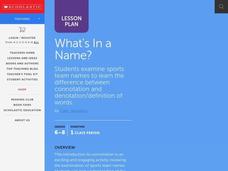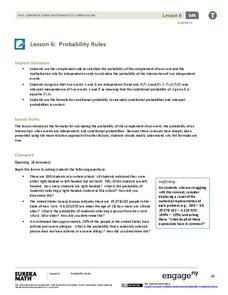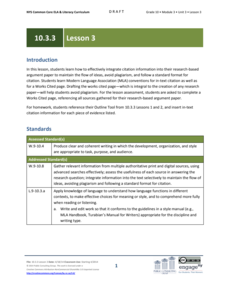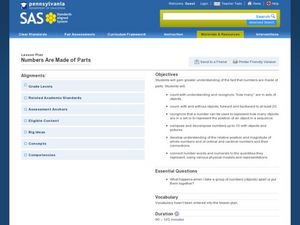Curated OER
Foods
Students identify what types of items are grown on a farm. They discuss how those items are processed and turned into food they everyday. They are to write a paragraph using transition words.
Have Fun Teaching
Context Clues (5)
Unfamiliar words can make it difficult to understand what a piece of writing is trying to say. Practice using context clues to define words you don't know with a language arts learning exercise, which features five sentences and enough...
Curated OER
What's In a Name?
Introduce your language arts class to connotation, denotation, and diction. Middle schoolers identify and differentiate between the connotative and denotative meanings of words by analyzing the fictitious sports team names. Learners...
Curated OER
Ordinary People: Desktop Teaching
Turn the pupil into the teacher to help your learners pick up and retain vocabulary from Ordinary People by Judith Guest. Each individual selects a word, studies it in depth, and then teaches their word to the rest of the class, one...
North Clackamas School District
Context Clues: Synonyms
What do you do when you find a word that's not familiar to you? Help readers use context clues when encountering unfamiliar words with a grammar activity. They note the parts of the sentences that show the meaning of the word, write how...
EngageNY
Close Reading: The Introduction to the Universal Declaration of Human Rights
As part of a group of lessons, your class will return to the primary text for this unit, the Universal Declaration of Human Rights. Key vocabulary as well as close reading strategies continue to be the focus skills; however, this lesson...
Charleston School District
Solving Systems with Substitutions
How many large and small watermelons did he sell? Just use the given information to write and solve a system of equations! The two videos accompanying the lesson explain the substitution method and then introduce problem solving. The...
National Endowment for the Humanities
The Preamble to the Constitution: A Close Reading Lesson
"We the people of the United States, in order to form a more perfect union..." These familiar lines begin the Preamble to the Constitution, but do learners know what they mean? A close reading exercise takes a look at the language of the...
Really Good Stuff
English/Spanish Cognates: Food
Everyone loves food! Help your English language learners pick up some vocabulary with a series of activities based around cognates and food. Pupils practice each word and focus on the words in-depth by filling out Frayer model...
EngageNY
Studying Conflicting Interpretations: Perspectives on Plessy v. Ferguson: Part 3
Scholars closely read Justice John Marshall Harlan's dissenting opinion in the Plessy v. Ferguson case, seeking to understand why he disagreed with the court's decision that racial segregation laws for public spaces were constitutional....
K12 Reader
Conjunctive Adverbs and Independent Clauses
Conjunctive adverbs are not conjunctions, but they can function as conjunctions when paired with appropriate punctuation. If that's too complicated for language arts learners, have them work on an activity that provides a word bank of...
EngageNY
Probability Rules (part 1)
In statistics, probability rules—literally! Learners use their previous knowledge and explore a set of rules for conditional probability, independent probability, and complements. Given different scenarios, they must determine what type...
EngageNY
Grade 10 ELA Module 3: Unit 3, Lesson 3
Who said that? Scholars now learn how to cite evidence, give ideas proper credit, and work to understand the meaning of plagiarism. Part of the activity includes looking at an MLA Citation handbook, handy when pupils create their works...
Curated OER
Prepositions-- the Relationship of a Noun To Another Word in the Sentence
For this grammar worksheet, learners investigate the use of prepositions in sentences to show relationships between nouns and other words. Students complete 40 examples including fill in the blank, preposition word search, changing...
Curated OER
Journey to Understanding Vocabulary
Students examine word parts. In this word study instructional activity, students practice breaking words into parts and using their knowledge of Greek roots, prefixes, and suffixes determine the words' meanings.
Curated OER
What Does Success Mean to Me?
One can't set goals until he knows what he needs to feel successful. Learners discuss what they believe it means to be successful. They then fill out a graphic organizer showing four different paths to a successful adult life.
Curated OER
"Inside Parts of a Computer Project" WebQuest
Middle schoolers participate in a role play situation in which they act as a private investigator to determine the parts found inside a computer. They complete web based research. They create a slide show that describes inner workings of...
East Stroudsburg University
In Your Own Words... Paraphrasing
How can you put a passage in your own words without changing the meaning of the original text? That is the question facing many young researchers. The advice modeled in this presentation is that writers read the passage carefully,...
Curated OER
What Does It Do? Parts of the Computer
This is a nice introduction for first graders to parts of the computer. It includes several resource links to PowerPoints to show the class. There is one activity for the class to do. This is a basic introduction, and could definitely be...
Illustrative Mathematics
Words to Expressions 1
Designed as a follow-up to the lesson plan titled Watch Out for Parenthesis 1, this activity asks young learners to write an equation for the calculation described with words rather than numbers and symbols. The treasure that 5th graders...
Curated OER
Spanish: Body Parts and Beyond
Students drill on Spanish vocabulary words by participating in a card game. They use a list of teacher-prepared clues that are glued to cards. Later they apply these words to skits and dialogues about health issues.
PB Works
“George Washington’s Socks”: Vocabulary Part 1
Supplement a class reading of George Washington's Socks with this list of vocabulary words. Including a mixture of verbs, nouns, adjectives, and adverbs, this resource asks young readers to record the page number and a synonym for each...
Curated OER
My School Goal (Part 3)
Third graders, while working in small groups, determine the meaning of evaluation and why they are evaluated in school. They individually assess themselves to determine how they did on their goal sheet, and prepare to continue the use of...
Pennsylvania Department of Education
Numbers Are Made of Parts
Children play with barnyard animal cards to practice composing and decomposing numbers. With their "secret number" of animal cards in a cup, they shake and spill them onto a barn story board, counting how many animals fall in the barn...

























